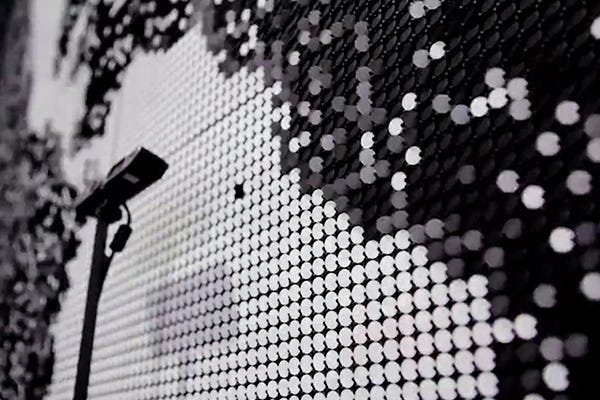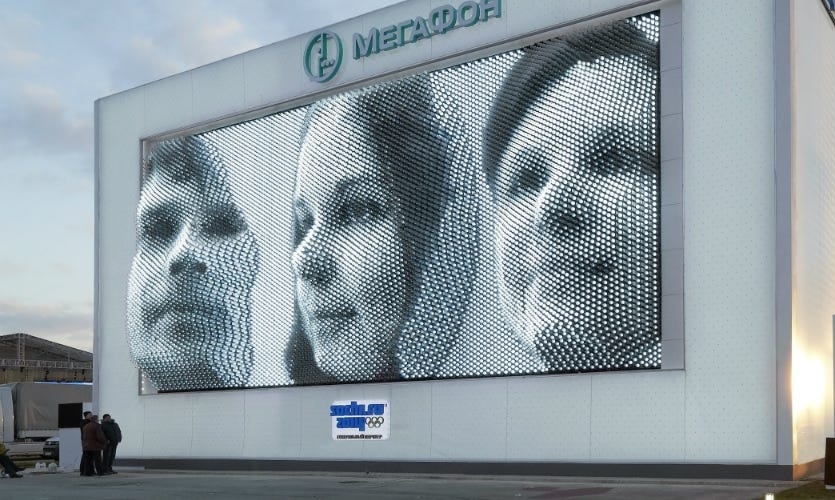Physical/Mechanical Displays
Flip-dot
Split Flap
Mechanical LED
Other Mechanical Approaches
Interactive Haptic
Ferrofluid

Some artists also work with display surfaces that don’t emit light or use optics at all. Most of these displays are entirely custom and work with a massive array of motors or other electromechanical means. Haptic communication is another big one that is being explored with this type of “display.” The line between sculpture and information display is really blurred with these, so its tough to quantify exactly what falls into a display and what is just a lot of motorized elements.
Flipdot
There are some commercially available physical displays such as Flipdot displays. There are just a few vendors for these in the world. These work by using electromagnets to flip a metal disk that has different colors on each side. They are capable of fairly simple graphics since they are essentially just binary pixels. There have been a few installations that have figured out how to make them switch fast enough to do full video representations. There is also an audio component to having so many elements mechanically flipping at once, as in this video of a large 588x216 resolution screen. There is also the potential to develop them to have the discs spin completely 360, which when combined with a variable speed, they would be able to represent grayscale values instead of just on-off.
Split Flap
Split flap displays are similar to flip-dot displays in their electromechanical approach and visual effect. These use a small register of individual image flaps that are flipped with a motorized element to display different information. These displays were used in old alarm clocks to display the time or on things like train billboards to show arrival/departure information. One of their most unique components is the noise they make when flipping between states.
While these have mostly fallen out of fashion for their limited ability to update, there are a few sources out there for custom Split flap displays, such at Oat Foundry. Oat Foundry offers some standard sized Split Flap displays that can be updated with text and images using a basic API. They also offer some custom options with their Picture Flap that allows for custom images to be set on their existing designs and flipped through as well
Mechanical LED
The company PJ-Link has a mechanical LED solution that combines an LED video wall panel with a robotic moving element that pushes and pulls out from the screen (Also worth nothing that PJ Link is the same name as a projector communication prototcol, but unrelated). There may be other manufacturers
of a similar technology, but most of the common examples seem to come from this company. At one point a similar technology was installed in Times Square but it wasn't there for very long. PJ Link also has other mechanical displays that fold, rotate, and slide.
Other Mechanical Displays

There are a ton of other variations on this same concept that either use an array of motors or electromagnets. The artist Daniel Rozin has been exploring this concept for years with a ton of different materials — trash, wood, penguin dolls, metal balls — etc. There are also pieces that take this concept into a third dimension and use elements suspended on wires to represent limited forms in 3D. The same concept has been applied to a fleet of drones that were used to render low resolution volumes.
These physical displays continue to get more sophisticated as the years go on. This display was created out of special spools of thread that had a gradient of colors on them. By knowing the motor’s position, the software was able to know which color was currently on the front of the display, allowing them to render pixelated portraits of user generated photos. This one called the Megafaces Pavilion was made of thousands of actuated LED elements that were used to render people’s faces for the 2014 Sochi Olympics.

The studio Breakfast also has a number of products and past installations that utilize electromechanical elements for different display techniques. They have used thread to create images such as the below project:
Breakfast also has a number of products like their Brixels and Pins that allow for larger electromechnical display capabilities.
Studios like Augmentl combine lighting elements and electromechanical elements in projects like Morph:
See also:
Interactive Haptics
As mentioned, these kinds of physical actuated displays are also used in conjunction with projection to add haptics as another layer of interaction and collaboration. The inFORM from MIT has been the classic example of this for the last couple years. Some researchers are even working on ways to use electrical signals to simulate textures on touch screens — but a full writeup on the future of haptics and displays is one for another article :)

This project uses actuators and elastic thread to create an interactive abstract topography

The technology below is also in the haptics space. Ultraleap uses ultrasonics to create a sort of physical feel above a screen. It feels a bit like a constant puff of air through a straw. TanvasTouch is a technology that essentially uses mild electrical current to simulate different textures on a glass touchscreen.
https://www.ultraleap.com - Ultrasonic feedback
TanvasTouch - haptic feedback on a touchscreen
Ferrofluid Displays
Ferrofluid displays use a material called ferrofluid (typically a mix of oil and iron particles) that is suspended in another medium (such as salt water). Positioning an array of electromagnets behind the fluid container, the ferrofluid can be manipulated to create some basic shapes and motion.
See also:
Fluid Reality: https://www.fluidreality.com/ - this is more of a haptic sensing device, but seems like it has potential from a display perspective as well.
Last updated
Was this helpful?